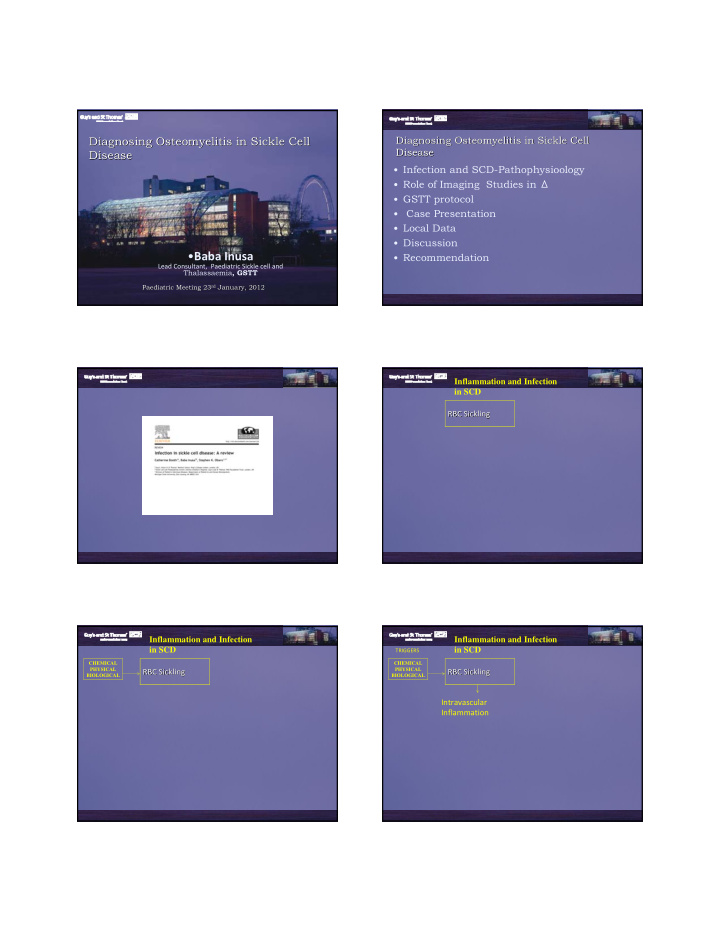



Diagnosing Osteomyelitis in Sickle Cell Diagnosing Osteomyelitis in Sickle Cell Diagnosing Osteomyelitis in Sickle Cell Diagnosing Osteomyelitis in Sickle Cell Disease Disease Disease Disease • Infection and SCD-Pathophysioology • Role of Imaging Studies in Δ • GSTT protocol • Case Presentation • Local Data • Discussion • Baba Inusa • Recommendation Lead Consultant, Paediatric Sickle cell and Thalassaemia , GSTT rd January, 2012 Paediatric Meeting 23 rd January, 2012 Paediatric Meeting 23 Inflammation and Infection in SCD RBC Sickling RBC Sickling Inflammation and Infection Inflammation and Infection in SCD in SCD TRIGGERS CHEMICAL CHEMICAL PHYSICAL RBC Sickling PHYSICAL RBC Sickling RBC Sickling RBC Sickling BIOLOGICAL BIOLOGICAL Intravascular Inflammation
Inflammation and Infection Inflammation and Infection in SCD in SCD TRIGGERS TRIGGERS CHEMICAL CHEMICAL PHYSICAL PHYSICAL RBC Sickling RBC Sickling RBC Sickling RBC Sickling Microcircula BIOLOGICAL BIOLOGICAL tory Obstruction Intravascular Intravascular Inflammation Inflammation ↑ Hemolysis ↑ Hemolysis ↓ Complement ↓ Complement ↑ Free Iron ↑ Free Iron ↑ R E S load ↑ R E S load Inflammation and Infection in SCD TRIGGERS End- Hyposplenism Hyposplenism CHEMICAL organ PHYSICAL RBC Sickling RBC Sickling Microcircula Encapsulated organisms disease BIOLOGICAL tory • Sluggish circulation Bowel Obstruction • Acidosis Intravascular Ischemia Splenic • Sickling Inflammation Infarction/ • Intrapsplenic shunts sequestration ↑ Hemolysis ↓ Complement • 30 ‐ 600x more prone to IPD ↑ Free Iron • Rapid onset; raid progression ↑ R E S load • V young most susceptible: • 5.8/100 in under 3s • 1.1 in 5 ‐ 9 • 0.6 >10yrs (Overturf 2003) Micronutrients Micronutrients Mechanical Mechanical • Zinc (Prasar 1999; Faker 2000) Bone infections • Known association with lymphopenia • ? Due to chronic glucocorticoid production from HPA axis • Expanded space from increased haemopoiesis • XS glucocorticoids stimulate B & T lymphocyte apoptosis in BM & • Sluggish circulation thymus • ↓ IL2 production • Causative organism • ↓ NK cell killing activity • Samlonella • ↓ CD4:CD8 • St aureus • ↓ Th1 helper activity • Gram neg – Bordatella • Zn deficiency • Haemolysis • Renal Acute chest syndrome • ??Empirical supplementation
Bone & joint infections Bone & joint infections • Non ‐ typhi Salmonella Osteomyelitis in SCD • Culture negative • Occult / under ‐ diagnosed • Long ‐ term disability if treated late Sickle Cell Disease Sickle Cell Disease Osteomyelitis v Acute Infarction Osteomyelitis v Acute Infarction Osteomyelitis (OM) vs Vasoocclusive crises (VOC) In the clinical scenario of a child with sickle cell disease • Osteomyelitis is one of the most common infections in • presenting with bony pain and swelling affecting a single children with sickle cell disease (artí-Carvajal et al M site, with prolonged fever and pain, the physician should 2009) consider closer monitoring and investigations to exclude a diagnosis of osteomyelitis- Elizabeth Berger et Arch Gold standard for diagnosis – Positive cultures, however • Pediatr Adolesc Med. 2009;163(3):251-255 this is not possible in the majority of cases. • Osteomyelitis most commonly affects the diaphyses of the The challenge is the ability to differentiate acute • Osteomyelitis from acute bone infarction even though it is femur, tibia or humerus. Laboratory-Leucocytosis and much rarer- 1:50. raised inflammatory markers-CRP-both infarction / osteomyelitis Periosteal and paraosteal soft tissue • Both clinical and radiological information may be enhancement cannot differentiate between these • indistinguishable (Berger E et al, 2009) conditions • Gold standard - Positive culture Sickle cell disease Osteomyelitis v Bone Sickle cell disease Osteomyelitis v Bone infarction: Role of radiological investigations infarction: Role of radiological investigations The principal ultrasonographic finding of subperiosteal • fluid was present in 14 (74%) patients with osteomyelitis and seven (37%) patients without infection. A finding of a Developing a local protocol Developing a local protocol subperiosteal fluid depth of 4mm or more was significantly associated with osteomyelitis ( P<0.01). William et al, Clinical Rad 2000; 55: 307-310 The value of Gadolinium enhanced MRI -Thick irregular • periphery, unaffected centre, Geographic enhancement with periosteal reaction. Umans et al– Umans, Mag Reson Imag 2000; 18: 255-262
Suspected Osteomyelitis in Sickle Cell Disease: St Thomas’ Hospital Dept Paediatrics Guideline for the evaluation & treatment Suspected Osteomyelitis or Soft tissue infection in Sickle Cell Disease Guideline for Imaging Ultrasound Examination History & Examination • Acute bone/soft tissue swelling +/- Always give adequate localised erythema or Joint pain / effusion analgesia 1 Positive utr. scan (>4mm Negative USS periostel fluid elevation • Fever 38.0 C Pain Persists Pain and signs • 3 phase bone isotope scan subside Aspiration and gram stain •FBC, Blood culture, CRP, Bone profile •Consider Plain Film X-ray if history >1week Scan is normal •Urine and Stool culture • Commence IV Ceftriaxone /suitable cover 4 Positive bone scan – Scan diagnostic suggestive of Salmonella 50mg/kg Repeat US or do MRI localised hot spot send for MRI (discuss with radiologist) •Imaging protocol Continue antibiotics Treat if Positive MRI-High CRP Well –Stop antibiotics Case 25/11/2004 ‐ 6 admissions 14/03- Pain / Swollen Right leg • USS- Extensive inflammatory reaction, periosteal coolection2mm • Ceftriaxone- 1week- D 20/06 • Right Leg- Swollen, X-Ray- Mixed sclerotic / lucent areas • MRI-?Proximal Tibia Osteomyelitis • IV Ceftriaxone(14d), Oral Clindamycin(4weeks) • 18/08/ Summary Summary Case 18/08-26/08 Ultrasound correctly identified 26/35 cases of • Osteomyelitis-benefits Left leg pain-tibia • • Fast and Simple but Operator dependent US-No effusion, No periosteal reaction • C-Reactive Protein correlates with ultrasound finding • Unresolved features- MRI-?Osteomyelitis left • MRI may be essential to clarify the diagnosis in a • Femur/Periosteal collection proportion of cases What to check • 16/10-22/10 C-RP- admission, repeat at least every three days / 7day • Pain left Leg-Tibia- X-ray- Normal • US then MRI • US-Collection17-repeat 19, • Orthopaedics role • 20/10- Surgical I&D-IV Ceftriaxone-6weeks • 2 further presentations with avascular necrosis of foot bones
Recommend
More recommend